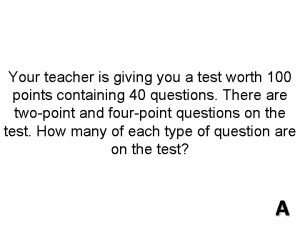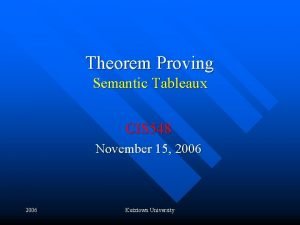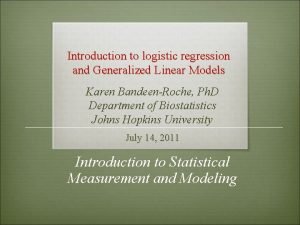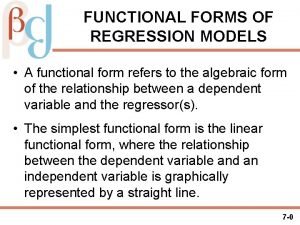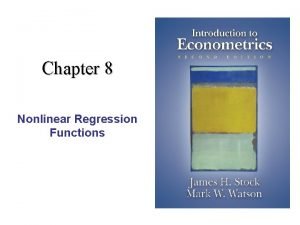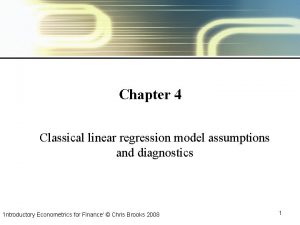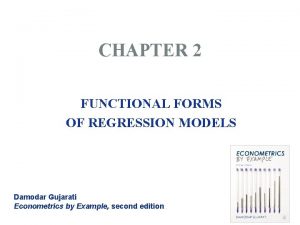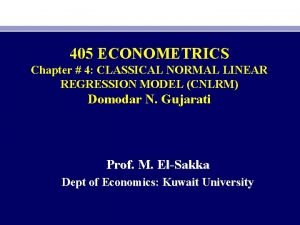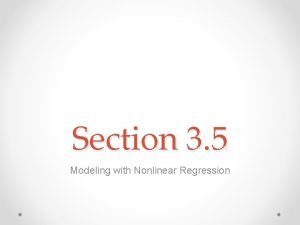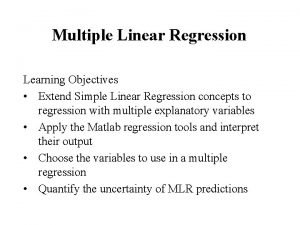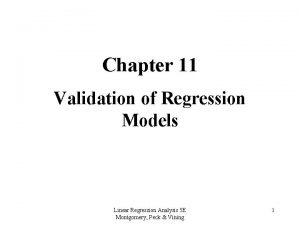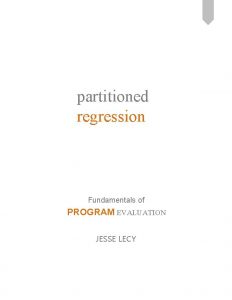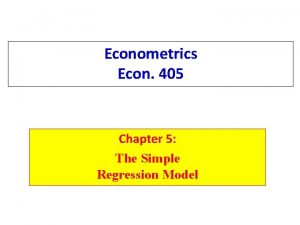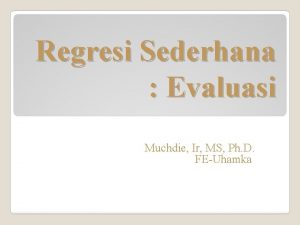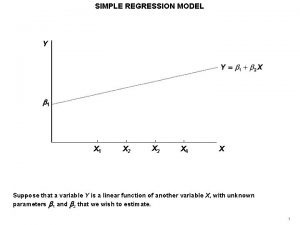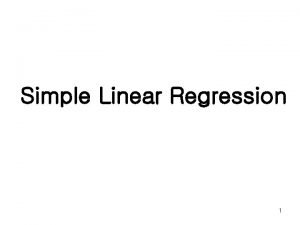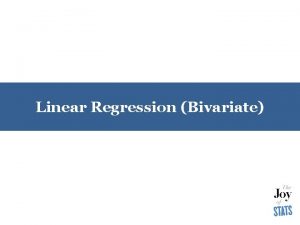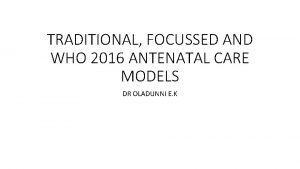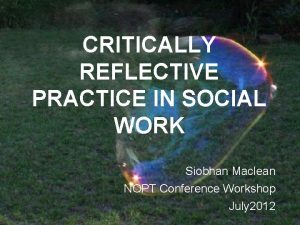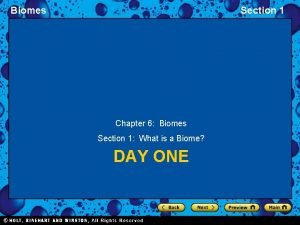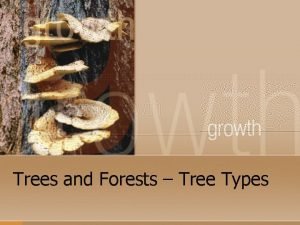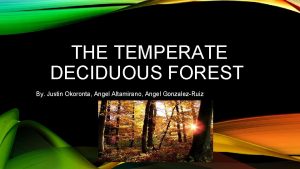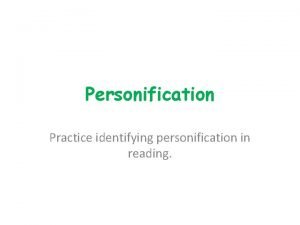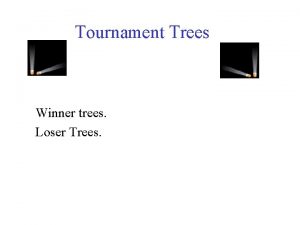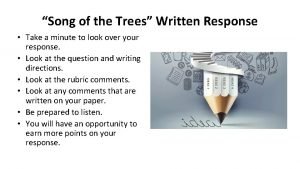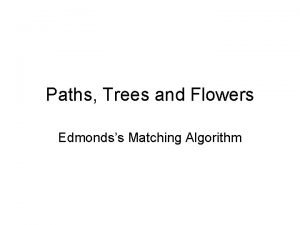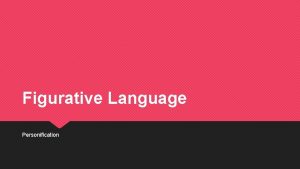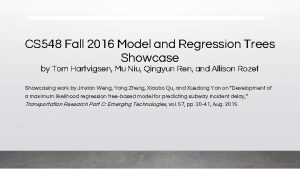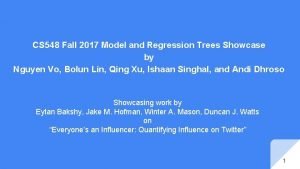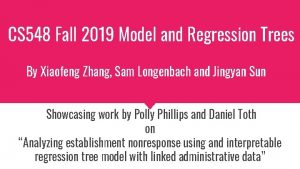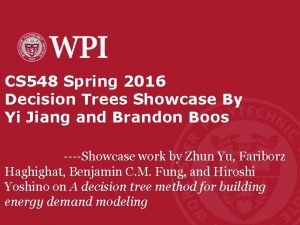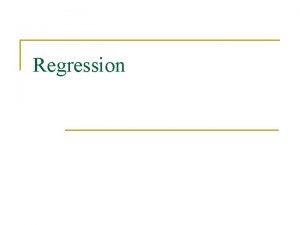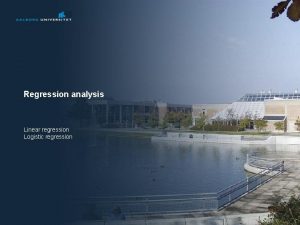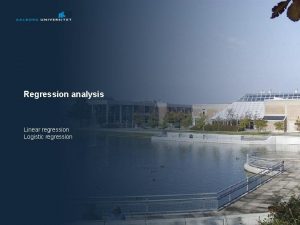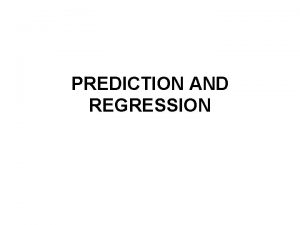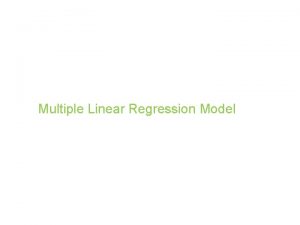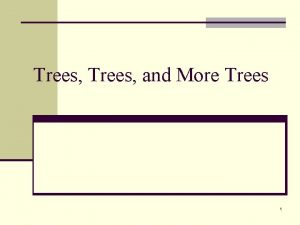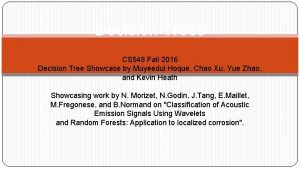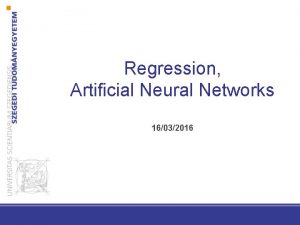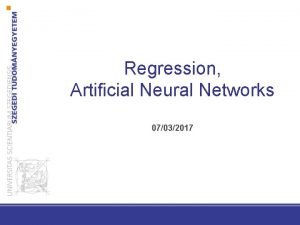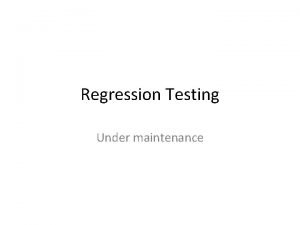CS 548 Spring 2016 Model and Regression Trees

![References [1] Fanelli, G. ; Gall, J. ; Van Gool, L. , "Real time References [1] Fanelli, G. ; Gall, J. ; Van Gool, L. , "Real time](https://slidetodoc.com/presentation_image_h/146fc773041e0d56d1f4968bfa7e81c5/image-2.jpg)






























![Construction of the Forest • Image taken from [1] http: //www. mathworks. com/help/stats/multivariat e-normal-distribution. Construction of the Forest • Image taken from [1] http: //www. mathworks. com/help/stats/multivariat e-normal-distribution.](https://slidetodoc.com/presentation_image_h/146fc773041e0d56d1f4968bfa7e81c5/image-33.jpg)






- Slides: 39

CS 548 Spring 2016 Model and Regression Trees Showcase by Yanran Ma, Thanaporn Patikorn, Boya Zhou Showcasing work by Gabriele Fanelli, Juergen Gall, and Luc Van Gool on Real Time Head Pose Estimation with Random Regression Forests
![References 1 Fanelli G Gall J Van Gool L Real time References [1] Fanelli, G. ; Gall, J. ; Van Gool, L. , "Real time](https://slidetodoc.com/presentation_image_h/146fc773041e0d56d1f4968bfa7e81c5/image-2.jpg)
References [1] Fanelli, G. ; Gall, J. ; Van Gool, L. , "Real time head pose estimation with random regression forests, " in IEEE Conference on Computer Vision and Pattern Recognition (CVPR), 2011, vol. , no. , pp. 617 -624, 20 -25 June 2011. doi: 10. 1109/CVPR. 2011. 5995458 URL: http: //ieeexplore. ieee. org/stamp. jsp? tp=&arnumber=5995458&isn umber=5995307 [2] Hastie, Trevor; Tibshirani, Robert; Friedman, Jerome (2008). The Elements of Statistical Learning (2 nd ed. ). Springer. ISBN 0 -387 -95284 -5. Page 587 -588

Outline • Application: Real Time Head Pose Estimation with Random Regression Forests • Background & Importance • Formulate the Problem – Input & Labels – Training Set & Test Set • Algorithm: Random Regression Forest • Results

Short Description This paper introduces a system that can detect head pose in real-time. The detection algorithm uses random regression forests, which utilize several regression trees to make predictions. Since images do not have typical features for tree construction, the trees were trained from sets of randomly generated rules that maximize information gain.

Background & Importance • Problem: want to detect head pose in real time Image taken from [1] • Importance: allows for higher-level face analysis tasks e. g. emotion detection

Input • What is the input? – extracted visual feature “channels” from patches: • depth values • X, Y, Z of geometric normal vectors • What is the resolution? – image in 640 x 480 range(fixed) – patches in 120 x 80 pixels (fixed) • What are patches? – randomly selected regions of pixels from an image

Image Channels Depth Normal Vector geometric normal vector source: https: //en. wikipedia. org/wiki/Normal_(geometry) source: https: //en. wikipedia. org/wiki/Depth_map

Each Image Will Look Like This 3 5 9 7 11 13 25 35 7 22 30 35 35 40 30 32 11 22 33 44 55 66 77 88 15 30 45 30 32 64 23 12 12 13 15 15 12 13 35 45 43 23 95 65 43 21 23 56 75 93 65 32 21 43 56 58 43 21 65 47 95 23

Input • What is the input? – extracted visual feature “channels” from patches: • depth values • X, Y, Z of geometric normal vectors • What is the resolution? – image in 640 x 480 range(fixed) – patches in 120 x 80 pixels (fixed) • What are patches? – randomly selected regions of pixels from an image

Patches • What are patches? – randomly selected regions of pixels from an image – patches in 120 x 80 pixels (fixed) – Patches will be samples Image taken from [1]

What Are They Trying to Predict Want: the direction the head is facing (the green line) Images taken from [1] The green line can be obtained if we know: - The location of the nose - The rotation of the head

Formulate the Problem: Labels • 6 Labels: – <x, y, z>: a vector from the center of a patch to the nose – <yaw, pitch, roll>: the rotation of the head Image taken from [1] Source: http: //howthingsfly. si. edu/flight-dynamics/roll-pitch-and-yaw

Training Set • Advantage of synthetic generated face images – Easy to obtain large amount images – Accurate label annotations – Zero noise Image taken from [1]

Training Set • Training Set: generated using 3 D model software – 50, 000 face images – All in 640 x 480 range – Random variation of <yaw, roll, pitch> = <± 95, ± 50, ± 20> Source: http: //howthingsfly. si. edu/flight-dynamics/roll-pitch-and-yaw Image taken from [1]

Test Set: ETH Face Pose Range Image Data Set https: //www. vision. ee. ethz. ch/datasets/headpose. CVPR 08/

Test Set • Test Set: ETH Face Pose Range Image Data Set – Well-known published head pose data set – Big data set: over 10, 000 images – Realistic data – Ground truth (labels) is provided – Each image is 640 x 480 – head pose range: ± 90 yaw and ± 45 pitch https: //www. vision. ee. ethz. ch/datasets/headpose. CVPR 08/

What is Random Regression Forest? • • A forest is a group of trees Random: each tree is trained with only a random subset of training set – Random subset of features – Random subsamples • Each tree behaves just like regular decision/regression tree.

What is Random Regression Forest? • Since each tree is trained on different subset and different features, they might be the same or different from one another

What is Random Regression Forest? • One prediction per input per tree, the final prediction: – nominal class (decision forest): majority votes – numeric class (regression forest): average prediction • Advantage of random forest: – Smaller training set per tree = smaller prediction variance – Less overfitting than trees • Refer to reference [2] for more details

Random Forest in This Application • Each tree is trained on a set of patches randomly sampled from training set • The data are all images, the “features” are totally different from the “obvious” features, such as weather=sunny. – How do they use the image to construct the tree? Image taken from [1]

What They Actually Do • Map of Image Channels i. e. depth, x, y, z 3 5 9 7 11 13 25 35 7 22 30 35 35 40 30 32 11 22 33 44 55 66 77 88 15 30 45 30 32 64 23 12 12 13 15 15 12 13 35 45 43 23 95 65 43 21 23 56 75 93 65 32 21 43 56 58 43 21 65 47 95 23

What They Actually Do • Randomly pick 2 regions of equal size: F 1 and F 2 3 5 9 7 11 13 25 35 7 22 30 35 35 40 30 32 11 22 33 44 55 66 77 88 15 30 45 30 32 64 23 12 12 13 15 15 12 13 35 45 43 23 95 65 43 21 23 56 75 93 65 32 21 43 56 58 43 21 65 47 95 23 • and randomly generated threshold value τ = 15

What They Actually Do • Sum the numbers in each region 3 5 9 7 11 13 25 35 7 22 30 35 35 40 30 32 11 22 33 44 55 66 77 88 15 30 45 30 32 64 23 12 12 13 15 15 12 13 35 45 43 23 95 65 43 21 23 56 75 93 65 32 21 43 56 58 43 21 65 47 95 23 F 1 (green) = 187. F 2 (blue) = 100

What They Actually Do • Compare F 1 - F 2 with threshold value. – If F 1 - F 2 > τ • right child – else • left child • In this case: F 1 - F 2 = 187 - 100 = 87 > 15 – So this patch belongs to the right child

What They Actually Do • If we pick F 1 (red) and F 2 (blue) • • • Image 1: F 1 – F 2 = 0 Image 2: F 1 – F 2 = -1 Image 3: F 1 – F 2 = -18 – Just by looking at F 1 and F 2, you can see image 3 is different from image 1 and 2. The similar patches will move into the same leaves.

Summary of the Algorithm • For each non-leaf, there is a “binary test” – Each binary test is defined by: regions (F 1 and F 2), threshold (τ), and channel subset (I) – If the sum(F 1. I_values) - sum(F 2. I_values) > τ • This patch belongs to the right child • Otherwise the left child

Construction of the Forest 50, 000 face images 3, 000 face images 25 patches per image Regression Tree 1 Regression Tree 2 Regression Tree 3

Construction of a Tree (in the Forest) Randomly generated rules for a node 75, 000 patches

Construction of a Tree (in the Forest) Separate patches with each rule. Compute entropy 75, 000 patches Rule: t 1 <yes, no> = <y 1, n 1> Entropy = e 1 Rule: t 2 <yes, no> = <y 2, n 2> Entropy = e 2 Rule: t 3 <yes, no> = <y 3, n 3> Entropy = e 3

Construction of a Tree (in the Forest) Select the rule that give the most information gain 75, 000 patches Rule: t 1 <yes, no> = <y 1, n 1> Entropy = e 1 Rule: t 2 <yes, no> = <y 2, n 2> Entropy = e 2 Rule: t 3 <yes, no> = <y 3, n 3> Entropy = e 3 Most information gain = lowest entropy = e 2 < e 1 AND e 2 < e 3

Construction of a Tree (in the Forest) Randomly generated rules for a node 75, 000 patches no n 2 patches Satisfy rule y 2 patches

Construction of the Forest • Each tree is trained on sampled 3, 000 face images – 25 120 x 80 patches of are generated from each face image • Tree construction 1. Generate a lot of binary tests randomly {F 1, F 2, I, τ} 2. Use each rule to split the data into left and right child 3. Choose rule that maximize information gain:
![Construction of the Forest Image taken from 1 http www mathworks comhelpstatsmultivariat enormaldistribution Construction of the Forest • Image taken from [1] http: //www. mathworks. com/help/stats/multivariat e-normal-distribution.](https://slidetodoc.com/presentation_image_h/146fc773041e0d56d1f4968bfa7e81c5/image-33.jpg)
Construction of the Forest • Image taken from [1] http: //www. mathworks. com/help/stats/multivariat e-normal-distribution. html

Experiments: Deal with Outliers • Discard all Gaussians with a variance > maxv = 400 • Remove outliers using 10 mean-shift iterations – Intuition: use “mean” to draw a sphere to find outliers • • Inside the sphere (green) = survive to the next iteration Outside the sphere (blue) = eliminated • Green cylinder = estimated face direction from estimated nose center Image taken from [1]

Results • Accuracy: 90. 4% (“correct” threshold = ± 10°) • Number of input channels (depth, x, y, z) – More = superior accuracy but slightly slower • Number of tree ≤ 15 and stride ≥ 20 – ≤ 40 ms/frame = 25 frames/sec = standard movie FPS • • • Intel Core i 7 @ 2. 67 GHz Increase tree = more accurate but slower Decrease stride =more accurate but slower Image taken from [1]

Real-Time Performance • Real-time System – Intel Core 2 Duo @ 2 GHz. 2 GB of RAM Image taken from [1]

Discussion • Did they do as they claim? – Real-time • Number of tree ≤ 15 and stride ≥ 20 – Accuracy • 90. 4% with 10° threshold • 6. 5%: all votes are deleted by mean-shift – In real-time system, video feed is 25 frames/seconds – There a lot of room for error correction

Question and Answer

Additional Figures • Performance of the algorithm with only depth compared to depth + <x, y, z> Graphs taken from [1]
 One night a theater sold 548 movie tickets
One night a theater sold 548 movie tickets Cis 548
Cis 548 695 rounded to the nearest ten
695 rounded to the nearest ten Ue 548/2014
Ue 548/2014 Classification and regression trees (cart)
Classification and regression trees (cart) Simple and multiple linear regression
Simple and multiple linear regression Kim ki duk spring summer fall winter
Kim ki duk spring summer fall winter Spring summer winter fall
Spring summer winter fall Multiple regression vs simple regression
Multiple regression vs simple regression Survival analysis vs logistic regression
Survival analysis vs logistic regression Logistic regression vs linear regression
Logistic regression vs linear regression Log linear regression model
Log linear regression model Functional form meaning
Functional form meaning Log linear regression model
Log linear regression model Assumption of the classical linear regression model
Assumption of the classical linear regression model Reciprocal model in econometrics
Reciprocal model in econometrics Classical normal linear regression model
Classical normal linear regression model 3-5 practice modeling with nonlinear regression
3-5 practice modeling with nonlinear regression In multiple linear regression model, the hat matrix (h) is
In multiple linear regression model, the hat matrix (h) is Linear regression model validation techniques
Linear regression model validation techniques Partitioned regression model
Partitioned regression model Econometrics simple regression model
Econometrics simple regression model Regression model evaluation
Regression model evaluation Value of y
Value of y Linear regression
Linear regression Multiple linear regression
Multiple linear regression Bivariate linear regression model
Bivariate linear regression model Who anc model
Who anc model Weather reflective model
Weather reflective model Chapter 6 biomes section 1 what is a biome
Chapter 6 biomes section 1 what is a biome Compare and contrast spring and neap tides.
Compare and contrast spring and neap tides. Zone opasnosti
Zone opasnosti Venn diagram of coniferous and deciduous trees
Venn diagram of coniferous and deciduous trees Venn diagram of coniferous and deciduous trees
Venn diagram of coniferous and deciduous trees Personification of sun
Personification of sun Winner tree loser tree
Winner tree loser tree Song of the trees theme
Song of the trees theme Loser tree algorithm
Loser tree algorithm Paths trees and flowers
Paths trees and flowers Personification for grass
Personification for grass
